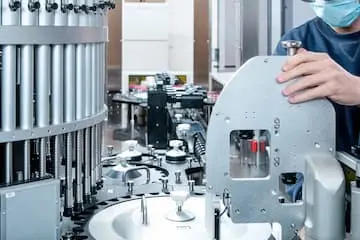A cold trap chiller is a specialized device that uses cooling methods to prevent vapors from contaminating vacuum pumps. The cold trap chiller works by condensing or sublimating gases like solvents and water vapors, rendering them harmless. These devices utilize active materials like dry ice, liquid nitrogen, or a Peltier element for cooling. They are most frequently used to condense gases, but they are also effective at trapping other types of contamination like solids. Cold trap chillers are ideal for cryogenic applications and are designed to withstand rapid temperature changes. They are an essential tool in any laboratory setting that uses vacuum pumps.
Toggle Categories
Get Instant Support
Choose your preferred way to connect with our team
-
Get Free Quote Fill out form for detailed pricing
-
Send Email Detailed inquiry support
-
WhatsApp Quick mobile chat
Response Time
Within 8 hours on working days, 24 hours on holidays
cold trap chiller

Vacuum Cold Trap Chiller Indirect Cold Trap Chiller
Item Number : KCT-2
We have the best Cold Trap Chiller solutions that will exceed your expectations. Our extensive portfolio virtually guarantees that there is an appropriate standard solution that will meet your needs. Our bespoke design service allows us to meet almost any customer requirement, providing you with a quality solution no matter what your available budget is.
Applications of Cold Trap Chiller
- Separation of solvent and solute
- Concentration of samples
- Preservation of samples
- Purification of compounds
- Removal of impurities
- Extraction of essential oils
- Fractional distillation of liquids
Advantages of Cold Trap Chiller
- Efficiently condenses and traps solvents, preventing them from contaminating the vacuum pump and the environment.
- Provides direct visibility of the condensate, making it easy to monitor the process.
- Reduces backstreaming of various oil molecules in the vacuum chamber.
- Increases the pumping speed of vapors from the container to the vacuum system.
- Safeguards vacuum pumps from being contaminated by vapors being condensed in the device.
- Makes vacuum pumps more efficient and less likely to break down.
- Prevents oil vapors from backstreaming from the pump back to the system.
- Uses a compact and leak-tight structure that doesn’t pass even an ounce of oil vapor.
- Allows for easy drainage of the condensate through its outlets.
- Saves energy and reduces overheads compared to traditional cold traps that use large amounts of nitrogen, tap water, and anti-freeze.
- Offers temperature range flexibility, making it suitable for a wide range of applications such as cryogenic applications, gas chromatography, and adsorption of noble gases, among others.
Our Cold Trap Chiller offers a cost-effective solution to your laboratory equipment needs. It is designed to provide efficient and reliable cooling for your cold trap system, ensuring minimal maintenance requirements. Our chiller also offers a complete customisation service, allowing us to cater to your specific needs and requirements. With its user-friendly design and compact size, our Cold Trap Chiller is easy to install and operate, making it an ideal choice for any laboratory. Trust us to provide you with a high-quality, customised solution at an affordable price.
FAQ
What Is A Cold Trap Chiller In Lab?
What Is The Purpose Of A Cold Trap Chiller?
Why Is A Cold Trap Placed Before The Vacuum Pump?
REQUEST A QUOTE
Our professional team will reply to you within one business day. Please feel free to contact us!
Related Articles

How Freeze-Drying Cuts Transport Costs by 90% in Critical Logistics
Freeze-drying slashes transport costs by 90% in logistics for space, military, and disaster relief by reducing weight and volume. Learn how it works.

Beyond the Spec Sheet: Matching Freeze Dryer Capabilities to Your Application's Critical Needs
Choose the right freeze dryer for pharma, food, or biotech. Key specs like cold trap temp, vacuum, and cooling rate impact drying speed and product quality.

Understanding Cold Traps in Lyophilizers: Key Factors and Evaluation Methods
Explores the role, evaluation, and common misconceptions of cold traps in lyophilizers, emphasizing the importance of water capture efficiency.

Understanding the Functionality of Cryogenic Cold Traps
An in-depth look at how cryogenic cold traps operate and their applications in various fields.

Applications of Dry Cold Traps in Various Processes
Dry cold traps are used in multiple applications to condense and collect gases, protecting equipment and improving process efficiency.

Optimal Cold Trap Temperature in Freeze Drying: Balancing Efficiency and Performance
Exploring the impact of cold trap temperature on freeze-drying efficiency and equipment performance.

Distinguishing Between Condensers and Coolers in Refrigeration Systems
Explores the key differences between condensers and coolers in chiller refrigeration systems, focusing on phase change, heat transfer coefficients, and series heat exchangers.

Cold Trap Design and Water Vapor Transport in Lyophilization
An overview of cold trap design and its impact on water vapor transport and product quality in the lyophilization process.

Common Pumps Used in Ultrahigh Vacuum Systems
An overview of the primary types of pumps utilized in ultrahigh vacuum systems, including mechanical, turbomolecular, sputtering ion, titanium sublimation, and cryogenic pumps.

Choosing the Right Laboratory Vacuum Pump
Guide on selecting appropriate vacuum pumps for various laboratory applications, considering types, uses, and vacuum degree calculations.

Advantages of Laboratory Circulating Water Vacuum Pumps
Explores the benefits of using laboratory circulating water vacuum pumps over traditional methods.

Lessons Learned from a Laboratory Vacuum Pump Oil Change Fire Incident
A detailed account of a fire incident during a vacuum pump oil change, highlighting the importance of proper maintenance and safety procedures.

The Most Frequently Used Equipment in the Synthesis Lab: The Circulating Water Vacuum Pump
Discover the often overlooked but crucial role of the circulating water vacuum pump in synthesis labs.

Optimized Selection of Vacuum Pumps for Object Adsorption
Guidelines for selecting miniature vacuum pumps considering theoretical calculations, practical flow, and safety factors.

Introduction to Common Laboratory Vacuum Pumps
An overview of various vacuum pumps used in laboratories, including molecular and rotary vane pumps.

Understanding the Vacuum Sintering Furnace: Components and Functions
An in-depth look at the key components of a vacuum sintering furnace and their roles in material sintering.

Basic Laboratory Refrigeration Equipment
Overview of essential refrigeration tools for labs.

Why a Chiller is a Must-Have for Your Rotavap
A rotary evaporator, or rotavap, is a laboratory device used for distillation. It is commonly used for removing solvents from a sample in a chemical reaction.

Why Tap Water Chilling Is Not Enough for Your Rotavap
Proper chilling is crucial for many laboratory applications, including rotavap. Without proper cooling, the solvent vapor produced during the rotavap process may condense in the wrong place and affect the quality of the final product.

Understanding the Features and Functions of Laboratory Press
Laboratory presses are essential equipment in various industries, offering precise and controlled sample preparation for testing and research purposes. These presses come with a range of features and functions that ensure reliable and consistent results. Understanding the capabilities of laboratory presses is crucial for businesses looking to optimize their sample preparation processes. From uniform temperature distribution to mechanical solidity, these presses offer a comprehensive solution for consistent sample thickness and closure force.
